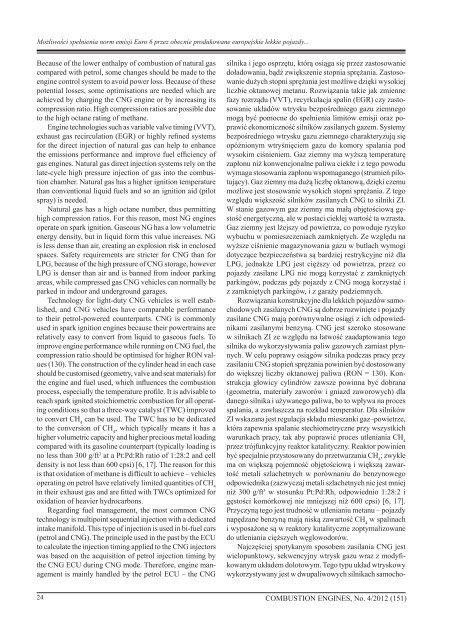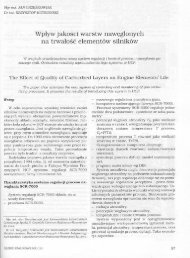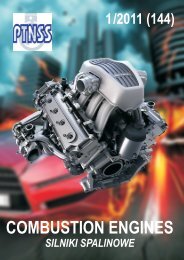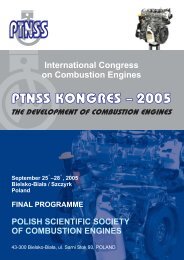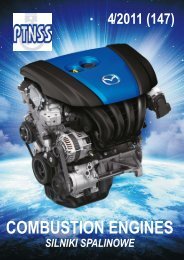You also want an ePaper? Increase the reach of your titles
YUMPU automatically turns print PDFs into web optimized ePapers that Google loves.
Możliwości spełnienia norm emisji Euro 6 przez obecnie produkowane europejskie lekkie pojazdy...<br />
Because of the lower enthalpy of combustion of natural gas<br />
compared with petrol, some changes should be made to the<br />
engine control system to avoid power loss. Because of these<br />
potential losses, some optimisations are needed which are<br />
achieved by charging the CNG engine or by increasing its<br />
compression ratio. High compression ratios are possible due<br />
to the high octane rating of methane.<br />
Engine technologies such as variable valve timing (VVT),<br />
exhaust gas recirculation (EGR) or highly refined systems<br />
for the direct injection of natural gas can help to enhance<br />
the emissions performance and improve fuel efficiency of<br />
gas engines. Natural gas direct injection systems rely on the<br />
late-cycle high pressure injection of gas into the combustion<br />
chamber. Natural gas has a higher ignition temperature<br />
than conventional liquid fuels and so an ignition aid (pilot<br />
spray) is needed.<br />
Natural gas has a high octane number, thus permitting<br />
high compression ratios. For this reason, most NG engines<br />
operate on spark ignition. Gaseous NG has a low volumetric<br />
energy density, but in liquid form this value increases. NG<br />
is less dense than air, creating an explosion risk in enclosed<br />
spaces. Safety requirements are stricter for CNG than for<br />
LPG, because of the high pressure of CNG storage, however<br />
LPG is denser than air and is banned from indoor parking<br />
areas, while compressed gas CNG vehicles can normally be<br />
parked in indoor and underground garages.<br />
Technology for light-duty CNG vehicles is well established,<br />
and CNG vehicles have comparable performance<br />
to their petrol-powered counterparts. CNG is commonly<br />
used in spark ignition engines because their powertrains are<br />
relatively easy to convert from liquid to gaseous fuels. To<br />
improve engine performance while running on CNG fuel, the<br />
compression ratio should be optimised for higher RON values<br />
(130). The construction of the cylinder head in each case<br />
should be customised (geometry, valve and seat materials) for<br />
the engine and fuel used, which influences the combustion<br />
process, especially the temperature profile. It is advisable to<br />
reach spark ignited stoichiometric combustion for all operating<br />
conditions so that a three-way catalyst (TWC) improved<br />
to convert CH 4<br />
can be used. The TWC has to be dedicated<br />
to the conversion of CH 4<br />
, which typically means it has a<br />
higher volumetric capacity and higher precious metal loading<br />
compared with its gasoline counterpart (typically loading is<br />
no less than 300 g/ft 3 at a Pt:Pd:Rh ratio of 1:28:2 and cell<br />
density is not less than 600 cpsi) [6, 17]. The reason for this<br />
is that oxidation of methane is difficult to achieve – vehicles<br />
operating on petrol have relatively limited quantities of CH 4<br />
in their exhaust gas and are fitted with TWCs optimized for<br />
oxidation of heavier hydrocarbons.<br />
Regarding fuel management, the most common CNG<br />
technology is multipoint sequential injection with a dedicated<br />
intake manifold. This type of injection is used in bi-fuel cars<br />
(petrol and CNG). The principle used in the past by the ECU<br />
to calculate the injection timing applied to the CNG injectors<br />
was based on the acquisition of petrol injection timing by<br />
the CNG ECU during CNG mode. Therefore, engine management<br />
is mainly handled by the petrol ECU – the CNG<br />
silnika i jego osprzętu, którą osiąga się przez zastosowanie<br />
doładowania, bądź zwiększenie stopnia sprężania. Zastosowanie<br />
dużych stopni sprężania jest możliwe dzięki wysokiej<br />
liczbie oktanowej metanu. Rozwiązania takie jak zmienne<br />
fazy rozrządu (VVT), recyrkulacja spalin (EGR) czy zastosowanie<br />
układów wtrysku bezpośredniego gazu ziemnego<br />
mogą być pomocne do spełnienia limitów emisji oraz poprawić<br />
ekonomiczność silników zasilanych gazem. Systemy<br />
bezpośredniego wtrysku gazu ziemnego charakteryzują się<br />
opóźnionym wtryśnięciem gazu do komory spalania pod<br />
wysokim ciśnieniem. Gaz ziemny ma wyższą temperaturę<br />
zapłonu niż konwencjonalne paliwa ciekłe i z tego powodu<br />
wymaga stosowania zapłonu wspomaganego (strumień pilotujący).<br />
Gaz ziemny ma dużą liczbę oktanową, dzięki czemu<br />
możliwe jest stosowanie wysokich stopni sprężania. Z tego<br />
względu większość silników zasilanych CNG to silniki ZI.<br />
W stanie gazowym gaz ziemny ma małą objętościową gęstość<br />
energetyczną, ale w postaci ciekłej wartość ta wzrasta.<br />
Gaz ziemny jest lżejszy od powietrza, co powoduje ryzyko<br />
wybuchu w pomieszczeniach zamkniętych. Ze względu na<br />
wyższe ciśnienie magazynowania gazu w butlach wymogi<br />
dotyczące bezpieczeństwa są bardziej restrykcyjne niż dla<br />
LPG, jednakże LPG jest cięższy od powietrza, przez co<br />
pojazdy zasilane LPG nie mogą korzystać z zamkniętych<br />
parkingów, podczas gdy pojazdy z CNG mogą korzystać i<br />
z zamkniętych parkingów, i z garaży podziemnych.<br />
Rozwiązania konstrukcyjne dla lekkich pojazdów samochodowych<br />
zasilanych CNG są dobrze rozwinięte i pojazdy<br />
zasilane CNG mają porównywalne osiągi z ich odpowiednikami<br />
zasilanymi benzyną. CNG jest szeroko stosowane<br />
w silnikach ZI ze względu na łatwość zaadaptowania tego<br />
silnika do wykorzystywania paliw gazowych zamiast płynnych.<br />
W celu poprawy osiągów silnika podczas pracy przy<br />
zasilaniu CNG stopień sprężania powinien być dostosowany<br />
do większej liczby oktanowej paliwa (RON = 130). Konstrukcja<br />
głowicy cylindrów zawsze powinna być dobrana<br />
(geometria, materiały zaworów i gniazd zaworowych) dla<br />
danego silnika i używanego paliwa, bo to wpływa na proces<br />
spalania, a zawłaszcza na rozkład temperatur. Dla silników<br />
ZI wskazana jest regulacja składu mieszanki gaz–powietrze,<br />
która zapewnia spalanie stechiometryczne przy wszystkich<br />
warunkach pracy, tak aby poprawić proces utleniania CH 4<br />
przez trójfunkcyjny reaktor katalityczny. Reaktor powinien<br />
być specjalnie przystosowany do przetwarzania CH 4<br />
; zwykle<br />
ma on większą pojemność objętościową i większą zawartość<br />
metali szlachetnych w porównaniu do benzynowego<br />
odpowiednika (zazwyczaj metali szlachetnych nie jest mniej<br />
niż 300 g/ft 3 w stosunku Pt:Pd:Rh, odpowiednio 1:28:2 i<br />
gęstości komórkowej nie mniejszej niż 600 cpsi) [6, 17].<br />
Przyczyną tego jest trudność w utlenianiu metanu – pojazdy<br />
napędzane benzyną mają niską zawartość CH 4<br />
w spalinach<br />
i wyposażone są w reaktory katalityczne zoptymalizowane<br />
do utleniania cięższych węglowodorów.<br />
Najczęściej spotykanym sposobem zasilania CNG jest<br />
wielopunktowy, sekwencyjny wtrysk gazu wraz z modyfikowanym<br />
układem dolotowym. Tego typu układ wtryskowy<br />
wykorzystywany jest w dwupaliwowych silnikach samocho-<br />
24 <strong>COMBUSTION</strong> <strong>ENGINES</strong>, No. 4/2012 (151)


